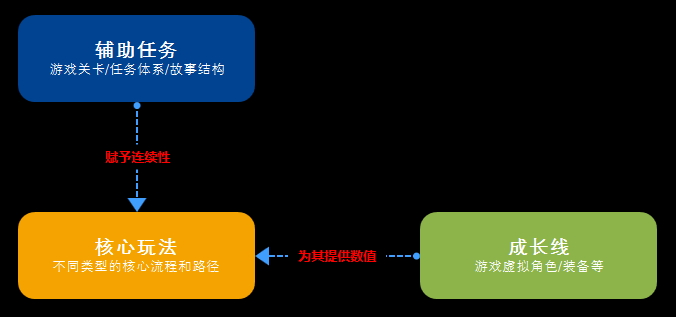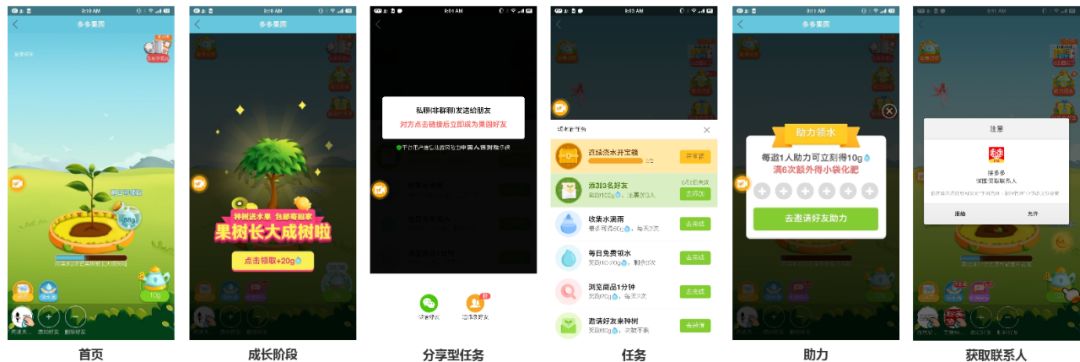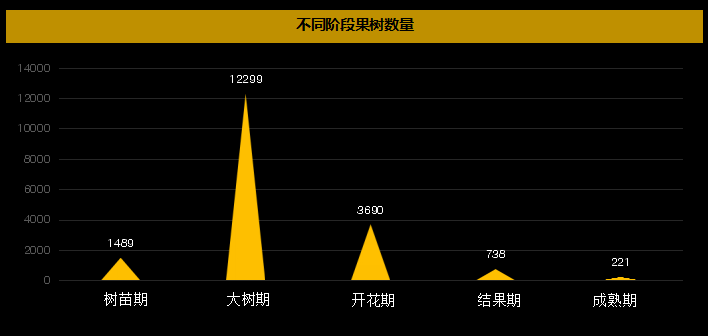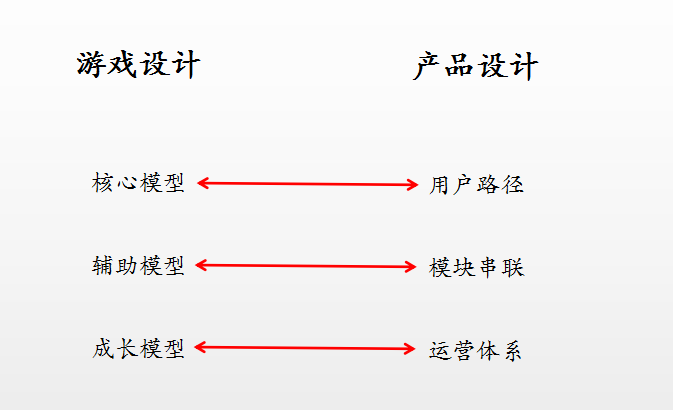The game design model can be divided into three parts: core model, auxiliary model and growth model.
Editor’s note: This article comes from WeChat public account “ Product dog gathering place ” (ID : Johntalking) by John Watermelon.
The game design model can be divided into three parts: core model, auxiliary model and growth model. The core model is the lowest level, just like the MVP version in the product, the auxiliary model and the growth model are the process of adding to it.
Before John the “subscriber growth Strategy Three footwork: product strategy, content Growth of Carriers and Products “ The growth of users must be divided into two dimensions: content carrier and marketing system. Among them, a very important branch of content carriers is product gamification.
Gamification refers to “applying game design ideas to non-game scenarios.” Because gamification design has excellent and significant effects, we use game design methods in product design to achieve product or business rationality. A set of goals. Such as the growth system, leaderboards, badges and other functions.
To the top, the growth system, leaderboard and other functions are actually just gamification.Accessibility features in the product. So what is the core? How to do tandem according to the product? After communicating with his friends who are game planners at Goose Factory, John will talk with you today about the thought of product gamification.
Is your product suitable for gamification?
Product gamification represents the productization of a complete set of operational processes, and more to provide products with indicators to promote new activities. (PS: It must be remembered here that if your product is not a game, then all gamification services are responsible for operational indicators) Then you need to know if your product is suitable for gamification? At what stage?
1.B-side products are not suitable for making. Because the B-end products are generally high customer price (requires payment, and the price is differentiated), and low frequency (internal use, only in the work scene). Corresponding operating strategies are available online and offline. Online is generally in the form of live broadcast, micro-lecture, video display, etc., mainly to explain the completeness of the system one by one. Offline is generally in the form of sponsored events, salons, exhibitions, etc.
2. Low frequency products are not suitable. If the product itself is very low frequency, such as marriage, job hunting, home purchase and car purchase, it is difficult to play any role. At the same time, users enter the product with their core pain points. Whether it can solve the core pain points of users is the most important. Conversely, if you do a gamified experience with this product, it will look unprofessional.
From the above two descriptions, in most cases, C-end products in the high-frequency sub-industry are more suitable for gamification. But at which point in the product can it be done?
3. Not suitable for seed stage. In the product seed stage, the first and more important thing is to build the product architecture and run through the core processes. It is built on the core processes, and it is essential to meet the main needs. At the same time, it is not clear at this stage of user portraits and layers, and what kind of gamified products are suitable for such users. So it becomes worthless.
4. Suitable for growth stage. The user portrait and user behavior were clarified, and a part of the original users accumulated. Gamification schemes can attract new users and wake up silent users, increasing the repurchase rate. A gamified product operation plan can’t be guaranteed, but positive trial and error is necessary at this stage.
Through the above four points, everyone should be clear about what type of products are suitable for the gamified operation system. This is equivalent to the stage of our product investigation.
Two, three elements of gamification design
After you know what products are suitable for gamification, you need to think about it next, how to do it? What does gamification include? Since thinking from the perspective of gamification design, we must first understand the game design model.
The game design model can be divided into three parts: core model, auxiliary model and growth model. The core model is the lowest level, just like the MVP version in the product, the auxiliary model and the growth model are on topAdding bricks and tiles.
Core model-different types of core processes and paths. This is what the game achieves, and what needs to be done to reach that goal. Core processes in internet products.
Auxiliary model-there are many ways to achieve this goal, what are these ways? Common related cards, tasks, stories, etc., through which can connect the context of the story, connect users and scenes, and enhance the sense of user involvement.
Growth model-for product playability and sense of achievement. The user’s growth system, hierarchy, and value gained in the game.
Through a graph to connect the relationship points:

In fact, the above are all theories. Next, let’s talk about the design ideas of product gamification through cases.
III. Deconstructing Product Gamification Models
A previous article also said that it is a lot of fun to gamify products to the extreme. Use the three elements of gamification to try to sort out the two mini-games “Toto Orchard” and “Toto Love Elimination”.
1. Duoduo Orchard

According to the three elements of game design:
a.Core gameplay
Relying on the three elements of gamification, the core gameplay of Duoduo Orchard is: the user makes the fruit tree from “seedling” → “big tree” → “flowering” → “fruit” → “mature” “Five stages until you get a box of fruit for free.
The core value is mainly the number of water droplets required by the fruit tree in the five stages of seedlings, large trees, flowering, fruiting and maturity. The backward derivation of the data can be calculated as follows:
How long do you want users to get this box of fruit? This value is N days.
How many water drops can I get per day? This value is M drops.
Can calculate the total number of water drops required: M * N
So how do you get M and N values? Need to involve auxiliary models and growth models.
b. Auxiliary model
The auxiliary model of Duoduo Orchard is the task system. The tasks include: adding friend rewards, daily login rewards, lucky bag, paying attention to public accounts, inviting friends, downloading apps, helping … The overall task system is divided into several categories: active, pull new, retention, guidance and activity conversion . John combed it with a form:

So for the core gameplay, the N value that can be received at most daily can be sorted out according to the table. (N value is the sum of daily water droplets)
c. Growth model
The growth models of Duoduo Orchard are mainly divided into two categories: tree growth models and additional water drop rewards.
The growth model of the tree is mainly the five stages of seedling, big tree, flowering, fruiting and maturity;
The extra water drop reward is mainly that the tree will get water drops through some additional activities at different stages. For example, the corresponding waterdrop lottery and waterdrop lottery are additional sources of waterdrops.
d. Data indicators for Duoduo Orchard
After each node in Duoduo Orchard has been buried, many interesting data can be analyzed. John sorted it out from several dimensions: (the data is all fictitious, I am not a lot of data analysis)

Explanation of the fields: new active users (this data includes active new users and old users), registration rate (registered users / UV), novice lead completion rate (novice lead completed users / registered users), Share rate (shared users / registered users), share return rate (Number of users / shares brought by sharing), Fission level (A share to B, count as one layer)

Through the time required for the number of fruit trees at different stages, and at the same time, according to the user’s active data, you can adjust the value to improve the user’s conversion and promotion.

Through the completion rate of the task, you can clearly understand the difficulty of completing different tasks and the value of the product. The corresponding value can be adjusted according to the target.
As mentioned above, it takes N days for a box of fruits to be harvested, and the total number of water drops required is M * N. The cost of fruit is A, and the acquisition cost of a single user is B. A / B users can get up to 1 box of fruit to maintain balance. Then the number of water droplets targeted at the customer can be increased accordingly, stimulating users to acquire customers. It may solve the problem fundamentally.
There are many other data collections for more useful parsing. You can study the product.
2. Too much love to eliminate

Similarly, according to the three elements of the game, John has teased out the overall mind map for Duodao elimination.

Among them, “passing rules”, “gameplay” and “scoring rules” are the core gameplay of the product, and the acquisition and consumption of “physical value”, “diamond” and “gold coins” are corresponding auxiliary models. (Because of the inflation of the house’s virtual currency, corresponding acquisition and consumption are required, and the rules determine the user’s promotion and retention).
Finally, you can analyze the user’s playability and activity level for a data model such as Duoduo Orchard to determine whether the goal has been reached.
The above two cases are just for the idea of Pinduoduo gamification. The most important thing is to set the standard through the carrier of the game and the user population that meets it.
Game design vs product design
There may be a question, how to compare the three elements of game design to product design?

The core model of game design is equivalent to the user path in product design, and the product process is combed according to the user path. A series of modules involved in the product process becomes an auxiliary model. The overall growth module is equivalent to how the function of the product can be used by users.
Finally, of course, the design through gamification may not be acceptable to all users. Gamification design is just one direction. The original intention of traceability is: What is the motivation for users?